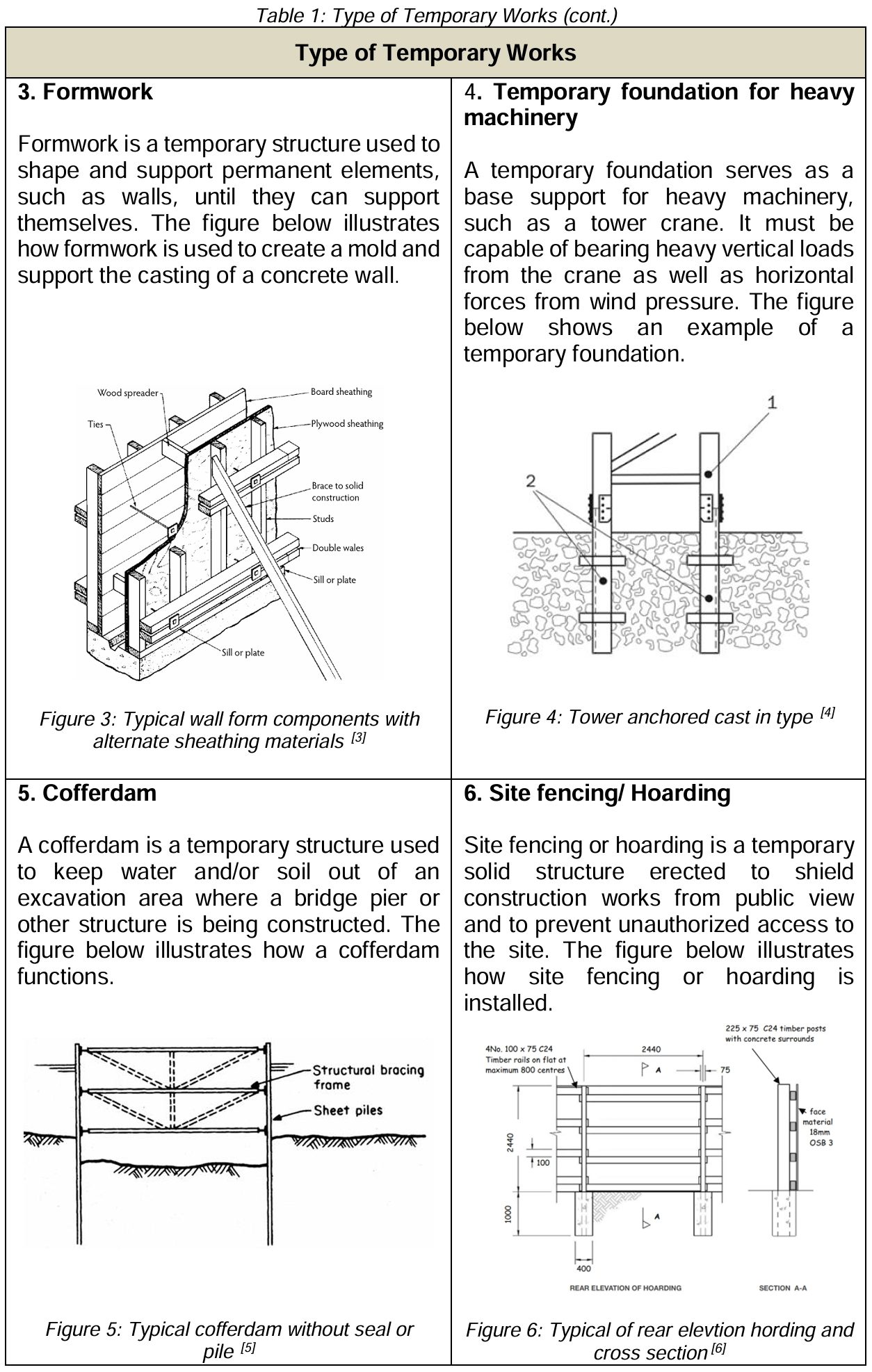Author: Ir. Dr. Justin LAI Woon Fatt | 24 May, 2025
In the construction industry, temporary works are crucial elements of construction projects, providing support and enabling the safe execution of permanent structures. Professional engineers (PEs) play a vital role in ensuring these temporary works are designed and executed with the utmost precision and in compliance with safety standards.
Temporary Works
Temporary works are structures, systems, or components that are needed during the construction or maintenance of permanent works or structures but are not intended to form part of the completed project. These temporary works provide support, safety, and access, allowing the main construction activities to be carried out efficiently and securely.
There are several reasons why temporary works or structures are required in the construction industry. These include support structures such as falsework, scaffolding, formwork, and molds; temporary foundations for heavy equipment or machinery support; water management systems such as cofferdams; and safety systems like site fencing.
Table 1 below outlines the various types of temporary works and their respective functions in the construction industry.
Based on the various types of temporary works briefly explained in Table 1, it is clear that these structures play a crucial role in ensuring the safety and stability of a construction project. Therefore, temporary works should not be taken lightly by any contractor, as they serve as essential support systems during different phases of construction. Neglecting the proper design, installation, and maintenance of these works can lead to structural failure, posing significant risks to workers, the public, and the overall project progress. Such failures may result in accidents, financial losses, project delays, and even legal consequences. Adherence to engineering standards and best practices is therefore essential to ensure the safety and integrity of temporary works.
PE Endorsement and Responsibilities for Temporary Works
According to Board of Engineers Malaysia (BEM) Guideline No. 001 ‘The Role and Responsibility of Professional Engineers for Temporary Works During Construction Stage’ [7], PE involved in a project play an active role in ensuring the safety and interest of the public, as well as the workers at the site. PE is responsible to ensure that the design of the temporary works can adequately support the permanent structures without failure until the construction process is completed.
Furthermore, as emphasized by BEM in Guideline 001, the design of any temporary works shall be given the same level of importance as the design of permanent works. PE is also responsible for ensuring that all designs for temporary works or structures comply with applicable laws and recognized design standards and practices, including:
-
-
- Occupational Safety and Health Act 1994 (Act 514) [8]
- JKR Specification for Occupational Safety and Health for Engineering Construction Works, 2011 [9]
- BS 5975:2008 – Code of Practice for Temporary Works Procedures and the Permissible Stress Design of Falsework [10]
- Construction Industry Development Board (CIDB) Guidelines [11][12]
- Malaysian Standard MS 1462 (Metal Scaffolding)
-
Improper Design and Supervision of Temporary Works Can Cause Fatality
As is well known, the design of temporary works or structures is critical for ensuring safety. A failure in any part of a temporary structure, such as its members or joints, can lead to structural collapse, potentially resulting in fatalities among workers. Figure 7 below shows an accident that occurred during the LRT extension project in Putra Heights, Subang, where the accident took place when the formwork and scaffolding collapsed during the concreting of the deck slab for the train depot.
![Figure 7: Failure of Temporary Works (Falsework) [13]](https://ipm.my/wp-content/uploads/2025/06/Figure7-Failure-of-Temporary-Works-Falsework-13.jpeg)
Figure 7: Failure of Temporary Works (Falsework) [13]
Conclusion
In conclusion, the safety of temporary works must be treated with the same level of importance as permanent structures. Therefore, PE verification and endorsement are crucial to ensuring that all aspects of temporary works are thoroughly reviewed before construction begins. This includes design considerations, material selection, and compliance with regulations set by the relevant authorities. These measures are essential for ensuring smooth construction progress while minimizing the risk of accidents, project delays, and financial losses.
Ir. Dr. Justin LAI Woon Fatt
CEO/ Founder
IPM Group
References:
[1] Kondratenko, V. E., Devyatiarova, V. V., Albul, S. V., & Kartyshev, D. S. (2020). Improving methodology for calculating scaffolding formwork of monolithic slabs in building constructions. IOP Conf. Series: Materials Science and Engineering. Retrieved on 24th May 2025 from https://iopscience.iop.org/article/10.1088/1757-899X/971/5/052037/pdf
[2] Ir. KB Lee (2016). Talk on “An Overview of Malaysian Standard MS1462 for Metal Scaffolding” . Retrieved on 24th May 2025 from https://www.cidb.gov.my/wp-content/uploads/2022/11/2.talk-on-overview-of-ms1462-2012-cidb-seminar-01-03-16.pdf
[3] David W. Johntson. (2008) Chapter 7: Design and Construction of Concrete Formwork. Retrieved on 24th May 2025 from https://www.academia.edu/26570483/Chapter_7_Design_and_Construction_of_Concrete_Formwork
[4] Watson, T., & Marchand, S. (2018). Tower Crane Foundation and Tie Design. CIRIA C761. Retrieved on 24th May 2025 from https://pdfcoffee.com/ciria-report-c761-tower-crane-foundation-and-tie-design-graham-garner-amp-partners-copy-pdf-free.html
[5] Professor Kamran M. Nemati (2007). Temporary structures, Lesson 4: Cofferdams. University Of Washington. Retrieved on 24th May 2025 from https://semspub.epa.gov/work/06/9595202.pdf
[6] Temporary Works Forum. (2020). Hoarding – A guide to good practice. Retrieved on 24th May 2025 from https://www.twforum.org.uk/viewdocument/hoardings-a-guide-to-good-practic-1
[7] Board of Engineers Malaysia. (2015). Guidelines No:001: The Role and Responsibility of Professional Engineers for Temporary Works During Construction Stage. Retrieved on 24th May 2025 from https://bem.org.my/uploads/ISO/ProfessionalPractice/c42e93cede498aa054f6164dbddd57fd.pdf
[8] Laws of Malaysia. (2024). Occupational Safety and Health Act 1994 (Act 514), As at 1 June 2024. Retrieved on 24th May 2025 from https://dosh.gov.my/wp-content/uploads/2025/01/Occupational-Safety-and-Health-Act-1994-Act-514_Reprint-Version-1.6.2024_English.pdf
[9] Jabatan Kerja Raya Malaysia. (2011). JKR Specification for Occupational Safety and Health for Engineering Construction Works. Retrieved on 24th May 2025 from https://www.jkrperak.gov.my/images/PDF/ARAHAN_KPKR/Arahan_KPKR_012012.pdf
[10] British Standards Institution (BSI). (2008). BS 5975:2008 – Code of Practice for Temporary Works Procedures and the Permissible Stress Design of Falsework. BSI British Standard. Retrieved on 24th May 2025 from https://www.scribd.com/document/497986455/BS-5975-2008
[11] Construction Industry Development Board (CIDB). (2021). Guideline for Developer & Contractor (Small & Medium): Migration from Conventional Method to IBS. Retrieved on 24th May 2025 from https://www.cidb.gov.my/wp-content/uploads/2022/07/211-Guideline-for-developer-contractor-small-medium-Migration-from-conventional-method-to-IBS_compressed-1.pdf
[12] Construction Industry Development Board Malaysia. (2021). CIS 22: 2021 Safe Use of Scaffolding in Construction. Retrieved on 24th May 2025 from http://stamp.cidb.gov.my/wp-content/uploads/2022/10/4.-CIS-22-2021.pdf
[13] Melissa Chi and Pathma Subramaniam. (2014). Two trapped in rubble as yet another collapse hits LRT line. Retrieved on 24th May 2025 from https://www.malaymail.com/news/malaysia/2014/12/24/three-trapped-in-rubble-as-yet-another-collapse-hits-lrt-line/807885



